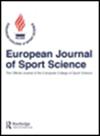垂直跳跃过程中力-速度关系的评估:起始位置、分析程序和载荷数量的影响
IF 3
3区 医学
Q2 SPORT SCIENCES
引用次数: 29
摘要
摘要本研究旨在比较90°深蹲跳(SJ90)和自我偏好的膝关节角度(SJpref)之间的力-速度(F-V)关系参数的可靠性和大小。第二个目的是探讨分析程序(力平台[FP]和Samozino [SAM]方法)和测试载荷数量(三点和两点方法)对F-V关系的影响。12名男性在SJ90和SJpref期间接受了两次测试。在每个会话中对三个外部负载执行两个相同的跳跃块。利用三种(三点法)或仅两种最远荷载(两点法)下收集的数据,通过FP和SAM程序确定每个区块的F-V关系参数(最大力、最大速度、F-V斜率和最大功率)。4个F-V参数的平均变异系数(CV)显示SJ90的信度高于SJpref (5.86% vs. 7.55%;CVratio = 1.29),使用FP (CVratio = 1.43)比使用SAM (CVratio = 1.14)的差异更明显,并且与FP相比,SAM的可靠性更高(6.14% vs. 7.27%;CVratio = 1.18)。与SJ90和FP相比,SJpref和SAM程序分别提供了相当或更高的F-V关系参数。三点和两点方法显示出可比较的可靠性和F-V关系参数大小的微小差异。采用SJpref法、SAM法和两点法可以简化F-V关系的常规检验程序。本文章由计算机程序翻译,如有差异,请以英文原文为准。
Assessment of the force-velocity relationship during vertical jumps: influence of the starting position, analysis procedures and number of loads
Abstract This study aimed to compare the reliability and magnitude of the force-velocity (F-V) relationship parameters between the squat jumps performed from the 90° (SJ90) and self-preferred knee angle (SJpref). A secondary aim was to explore the effect of the analysis procedure (force platform [FP] and Samozino's [SAM] method) and the number of loads tested (three- and two-point methods) on the F-V relationships. Twelve men were tested in two sessions during the SJ90 and SJpref. Two identical blocks of jumps were performed in each session against three external loads. The F-V relationship parameters (maximum force, maximum velocity, F-V slope and maximum power) were determined at each block through the FP and SAM procedures using the data collected under three (three-point method) or only the two most distant loads (two-point method). The average coefficient of variation (CV) of the four F-V parameters revealed a higher reliability for the SJ90 compared to the SJpref (5.86% vs. 7.55%; CVratio = 1.29) with more pronounced differences using the FP (CVratio = 1.43) than the SAM procedure (CVratio = 1.14), and higher reliability for the SAM compared to the FP (6.14% vs. 7.27%; CVratio = 1.18). The SJpref and SAM procedures provided comparable or higher magnitude of the F-V relationship parameters than the SJ90 and FP, respectively. The three- and two-point methods revealed a comparable reliability and trivial differences in the magnitude of the F-V relationship parameters. The routine testing procedure of the F-V relationship could be simplified using the SJpref, the SAM procedure and the two-point method.
求助全文
通过发布文献求助,成功后即可免费获取论文全文。
去求助
来源期刊
CiteScore
6.60
自引率
3.10%
发文量
153
审稿时长
6-12 weeks
期刊介绍:
The European Journal of Sport Science (EJSS) is the official Medline- and Thomson Reuters-listed journal of the European College of Sport Science. The editorial policy of the Journal pursues the multi-disciplinary aims of the College: to promote the highest standards of scientific study and scholarship in respect of the following fields: (a) Applied Sport Sciences; (b) Biomechanics and Motor Control; c) Physiology and Nutrition; (d) Psychology, Social Sciences and Humanities and (e) Sports and Exercise Medicine and Health.

 求助内容:
求助内容: 应助结果提醒方式:
应助结果提醒方式:


